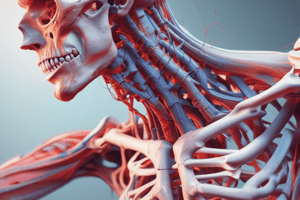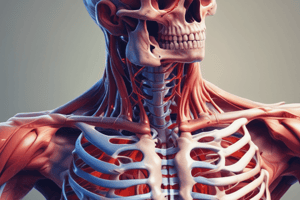Podcast
Questions and Answers
What is the primary function of the gluteus medius muscle?
What is the primary function of the gluteus medius muscle?
- Knee flexion
- Hip adduction
- Hip abduction (correct)
- Hip extension
Which of the following describes the quadriceps femoris muscle?
Which of the following describes the quadriceps femoris muscle?
- It is a two-part muscle.
- It is located on the back of the thigh.
- It is responsible for hip adduction.
- It provides extension to the knee joint. (correct)
What role does the gastrocnemius muscle play in movement?
What role does the gastrocnemius muscle play in movement?
- It provides dorsi flexion of the foot.
- It aids in the abduction of the arm.
- It causes hip joint extension.
- It enables the leg to flex and rise on tiptoe. (correct)
Which muscle is known as the boxer muscle due to its role in arm movement?
Which muscle is known as the boxer muscle due to its role in arm movement?
What is the main purpose of the trapezius muscle?
What is the main purpose of the trapezius muscle?
What is the primary function of skeletal muscles?
What is the primary function of skeletal muscles?
Which contraction occurs without any change in muscle length?
Which contraction occurs without any change in muscle length?
Which of the following describes a motor unit?
Which of the following describes a motor unit?
What is the term for the place where muscle attaches to bone?
What is the term for the place where muscle attaches to bone?
What is the muscle known as the 'vaccine muscle' that contributes to the shoulder's round shape?
What is the muscle known as the 'vaccine muscle' that contributes to the shoulder's round shape?
How are muscles generally named?
How are muscles generally named?
Which muscle is known as the strongest flexor of the thigh?
Which muscle is known as the strongest flexor of the thigh?
What does the term 'innervation' indicate?
What does the term 'innervation' indicate?
What type of joints are characterized by a lack of movement between the ends of the bones?
What type of joints are characterized by a lack of movement between the ends of the bones?
Which type of joints are referred to as non-synovial joints?
Which type of joints are referred to as non-synovial joints?
What is the role of the synovial membrane in synovial joints?
What is the role of the synovial membrane in synovial joints?
Which of the following movements is defined as 'bending' in the sagittal plane?
Which of the following movements is defined as 'bending' in the sagittal plane?
Which axis extends from top to bottom and is associated with internal and external rotation?
Which axis extends from top to bottom and is associated with internal and external rotation?
What is the opposite movement of pronation?
What is the opposite movement of pronation?
What does 'abduction' specifically refer to in terms of limb movement?
What does 'abduction' specifically refer to in terms of limb movement?
Inversion of the foot results in which of the following actions?
Inversion of the foot results in which of the following actions?
Flashcards
Gluteus Medius Function
Gluteus Medius Function
The gluteus medius muscle abducts the hip.
Quadriceps Femoris Function
Quadriceps Femoris Function
The quadriceps femoris extends the knee and flexes the hip.
Tibialis Anterior Function
Tibialis Anterior Function
The tibialis anterior dorsiflexes the ankle.
Triceps Surae Function
Triceps Surae Function
Signup and view all the flashcards
Pectoralis Major Function
Pectoralis Major Function
Signup and view all the flashcards
Fibrous Joints
Fibrous Joints
Signup and view all the flashcards
Cartilaginous Joints
Cartilaginous Joints
Signup and view all the flashcards
Synovial Joints
Synovial Joints
Signup and view all the flashcards
Flexion
Flexion
Signup and view all the flashcards
Extension
Extension
Signup and view all the flashcards
Abduction
Abduction
Signup and view all the flashcards
Adduction
Adduction
Signup and view all the flashcards
Anatomical Axis - Sagittal
Anatomical Axis - Sagittal
Signup and view all the flashcards
Skeletal Muscle Function
Skeletal Muscle Function
Signup and view all the flashcards
Motor Unit
Motor Unit
Signup and view all the flashcards
Tendon
Tendon
Signup and view all the flashcards
Isometric Contraction
Isometric Contraction
Signup and view all the flashcards
Isotonic Contraction
Isotonic Contraction
Signup and view all the flashcards
Origin
Origin
Signup and view all the flashcards
Insertion
Insertion
Signup and view all the flashcards
Myology
Myology
Signup and view all the flashcards
Study Notes
Joints and Muscles
- Joints connect bones, enabling movement.
- Muscles produce movement by pulling on bones.
- Joints are classified by their movement and structure:
- Fibrous joints: Immovable or have slight movement.
- Cartilaginous joints: Connected by cartilage; limited movement.
- Synovial joints: Have a fluid-filled cavity; most mobile.
- These joints have articular cartilage, a capsule, ligaments, and synovial fluid.
Types of Joints
-
Fibrous joints:
- Offer little to no movement.
- Examples: Sutures of the skull, distal tibiofibular joint.
- Function: Hold bones tightly together.
-
Cartilaginous joints:
- Allow limited movement.
- Examples: Pubic symphysis, intervertebral discs.
- Function: Provide cushioning and slight flexibility.
-
Synovial joints:
- Highly mobile joints.
- Examples: Knee, hip, shoulder.
- Function: Enable wide range of motion.
Types of Synovial Joints
- Classified by shape:
- Ball-and-socket: Wide range of motion (e.g., shoulder, hip).
- Hinge: Flexion and extension (e.g., elbow, knee).
- Pivot: Rotation (e.g., atlas and axis).
- Saddle: Bends in two directions (e.g., thumb).
- Plane: Sliding movement (e.g., intercarpal joints).
- Condylar: Movement in two directions (e.g., metacarpophalangeal joints).
Anatomical Axes
- Sagittal axis: Runs from front to back.
- Vertical axis: Runs from top to bottom.
- Frontal axis: Runs from side to side.
Types of Movement
- Flexion: Decreases the angle between two bones.
- Extension: Increases the angle between two bones.
- Abduction: Movement away from the body's midline.
- Adduction: Movement toward the body's midline.
- Rotation: Movement around a central axis.
- Circumduction: Circular movement.
- Supination: Rotation of the forearm so the palm faces forward.
- Pronation: Rotation of the forearm so the palm faces backward.
- Inversion: Movement of the sole of the foot inward.
- Eversion: Movement of the sole of the foot outward.
- Dorsiflexion: Bending the foot upward.
- Plantar flexion: Bending the foot downward.
Muscle Types
- Skeletal muscle: Voluntary movement, attached to bones.
- Cardiac muscle: Involuntary, found in the heart.
- Smooth muscle: Involuntary, found in the digestive system and other organs.
Skeletal Muscle Function
- Movement production
- Heat generation
- Stabilization
- Posture maintenance
Terminology of Muscles
- Origin: Point of attachment of muscle to stationary bone.
- Insertion: Point of attachment of muscle to movable bone.
- Tendon: Cord of fibrous tissue connecting muscle to bone.
- Aponeurosis: Flattened, sheet-like tendon.
- Contraction: Muscle shortening.
- Isometric: No change in muscle length.
- Isotonic: Change in muscle length.
Motor Units
- Motor neuron and all muscle fibers it innervates.
- Not all motor units need to contract simultaneously.
Naming Muscles
- Based on shape, location, size, action, number of origins.
Shoulder Girdle (Deltoid)
- Rounding the shoulder
- Abduction
- Flexion
- Extension
Brachial Region (Biceps Brachii)
- Flexion
- Supination
Brachii Region (Triceps Brachii)
- Extension of forearm
Hip Region (Iliopsoas)
- Flexion of the thigh
Gluteus Maximus
- Hip extension
Gluteus Medius
- Hip abduction
Femoral Region (Quadriceps Femoris)
- Knee extension
- Hip flexion
Crural Region (Tibialis Anterior)
- Dorsiflexion of ankle
Crural Region (Triceps Surae)
- Plantar flexion of ankle
Thoracic Region (Pectoralis Major)
- Adduction of the arm
- Rotates arm upward
Diaphragm
- Important muscle for respiration
- Separates the thoracic and abdominal cavities.
Dorsal Region (Trapezius)
- Prevents shoulder collapse
Abdominal Region
- Assists in movement, pressure, and organ functions.
Facial Muscles
- Control facial expressions
- Originate from bones or fascia, insert into facial skin.
Studying That Suits You
Use AI to generate personalized quizzes and flashcards to suit your learning preferences.




